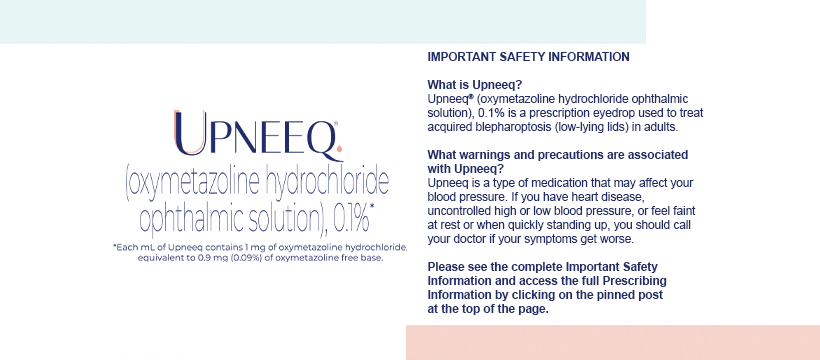

In her rural practice in Hanover, New Hampshire, Dorothy Hitchmoth, OD, ABO, ABCMO, FAAO, sees many older patients who have various medical conditions and for whom eyelid surgery is not indicated. There were few non-surgical solutions for blepharoptosis– which is why Dr. Hitchmoth was intrigued when she started to hear about Upneeq® (oxymetazoline hydrochloride ophthalmic solution), 0.1% from RVL Pharmaceuticals, a once-daily, preservative-free eyedrop indicated for the treatment of acquired blepharoptosis in adults.
“I was excited to start trying it with my patients, but I first decided to try it on myself,” she says. “I have ‘low-hanging eyelids’ and was rather surprised by the gain in visual function I experienced. I have ‘normal’ vision but after installation of Upneeq, I had improved vision in a way that I did not expect, given my relatively small degree of age-related aponeurotic ptosis. I thought the effect of expanding my visual field would be negligible, and I was wrong. I truly appreciated the impact in both normal and low-light conditions that I experience as part of my workday seeing patients. This was all a pleasant surprise, so I started in-office trials with enthusiasm.”
She realized that if the visual performance was so much better for her, it could make an even more dramatic difference for her patients. “It improved vision for patients with age-related macular degeneration, for example, because expansion of the superior field increased enhanced both reading and navigation capabilities. Estimating subjective visual function in an elderly person with both senile miosis and lid ptosis is a balance, and the impact of improved field and lighting can make enough difference to allow for safer navigation in the home or provide just enough additional lighting to allow for improved use of current low vision devices.
As she continues to work with it, she believes the impact for patients with vision-limiting issues could be impressive, especially when used with other adaptive and assistive technologies. “I keep saying that Upneeq may have more applications than originally thought,” she says.
A VISION-CHANGER
Dr. Hitchmoth presents it as a “vision-changer” for patients about age 55 and older. “If they have upper or lower lids that cover part of the pupil, they may notice a marked difference,” she says. Since Upneeq works quickly, patients can also decide when they want to use it. “They don’t have to use it all the time, but it’s good that they know they can use it if they want to. There are minimal contraindications, and for those whose who have a complex medical history, it can be an excellent option.”


Upneeq directly activates α-adrenergic receptors in Müller’s muscle, stimulating contraction and elevation of the upper eyelids in adults with low-lying lids.1
The gains in functional vision are far more important to her patients than the cosmetic impact. “These patients aren’t looking for a cosmetic solution. They want more light and better vision, and that’s what they’re getting.”
According to RVL Pharmaceuticals, Upneeq demonstrated three times greater improvement in visual field compared to vehicle in clinical trials (P<.01), as measured by Leicester Peripheral Field Test (on Day 1 and Day 14 of treatment).1
ASK ABOUT EYELIDS
Many doctors do not ask patients about their eyelids or lid position. That leaves patients thinking that if the doctor did not bring it up, there must be nothing available to help them, she says. She completes a quick assessment in the office. First, she asks patients if they if they have noticed that their eyelids are in the way of their pupil. “Many patients are aware of it,” she says.
“The second thing that I do is I have them look at the eye chart, and I’ll reach over and pull their lids out of the way. I ask if they can see better when I do that. If they say yes, they’re likely a candidate for Upneeq.”
Dr. Hitchmoth cautions that if optometrists are not asking patients about their eyelids, they’ll get their information from other sources, most often their friends or social media. “Any optometrist who is in a contact lens practice really should be paying attention to a patient’s lid position. As the muscles weaken and patients run the risk of developing acquired ptosis, I like to education them. We really can improve their vision,” she says. “I still think my personalized advice is better than Dr. Google for now!”
FOCUS ON VISUAL FUNCTION
Dr. Hitchmoth emphasizes that the first conversation should be on visual function. “We have an opportunity here to have conversations about visual function, and we can offer another solution in our toolbox of options. For many of our patients, lifting the eyelid one or two millimeters really can change their visual function. We can improve their quality of life with a noninvasive option,” she says.
References: 1. Upneeq® (oxymetazoline hydrochloride ophthalmic solution), 0.1%. [Prescribing Information]. RVL Pharmaceuticals, Inc. 2020.



